PLEASE remember that this is an old mining
area and do not leave the official footpaths
Setting the scene
The Southern Upland fault line is from just south of Ballantrae
(Ayrshire) on the west and to Dunbar on the east. The rock is
predominantly sedimentary, grey coloured, sandstone known as
greywacke, and it is punctuated with tiny pebbles of granite. The
foundations of this rock were laid between 495 - 417 million years
ago in the Ordovician and the Silurian times.
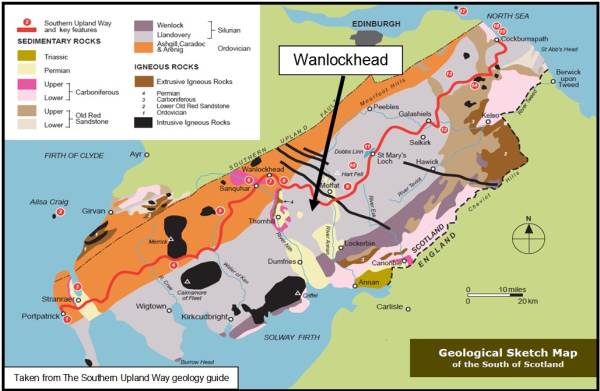
Southern Scotland’s Geology
A complete geological column - this will give you an idea
of where the rocks in Southern Scotland fit in to the history of
the structure of the UK
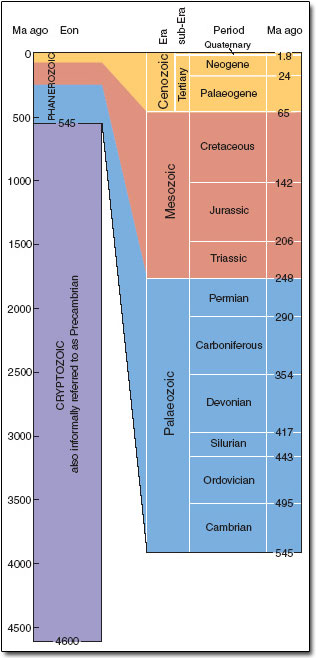
Geological column
With thanks to
Openlearn Education
Riches of the Earth
The main mineral mined at Wanlockhead was the Lead Ore,
Galena
The lead ore, or galena, yielded about 60% pure lead. Lead was
for many centuries the mainstay of the village's economy, but it
was not the only mineral found here. What became known as "God's
Treasure House" also produced zinc, copper, silver and gold. Some
of the world's purest gold, at 22.8 carats, was found locally and
used in the Regalia of the Scottish Crown.
Physical Characteristics and Structure of Galena
• Chemical Formula: PbS
• Colour is lead to silver gray sometimes with a bluish
tint.
• Lustre is metallic to dull in weathered faces.
• Transparency crystals are opaque.
• Crystal System is isometric; 4/m bar 3 2/m
• Crystal Habits include the cube, octahedron and combinations
of the two. Spinel twinning is possible forming flattened crystals.
Also massive and granular.
• Cleavage is perfect in four direction forming cubes. •
Fracture is uneven and rarely seen because of the perfect
cleavage.
• Hardness is 2.5+ • Specific Gravity is approximately
7.5+ (heavy even for metallic minerals)
• Streak is lead gray
• Associated Minerals are calcite, dolomite, sphalerite,
pyrite and other sulphide minerals, also lead oxidation minerals
such as cerussite and anglesite.
• Other Characteristics: brighter metallic lustre on cleavage
surfaces than on crystal faces.
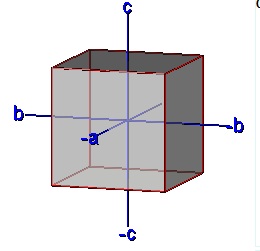
Crystal Structure of Galena
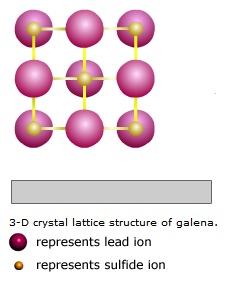
Atomic Structure of Galena
Galena is practically the only source of lead and an important
ore of silver. Metallic lead is used chiefly as follows:
• for conversion into white lead (a basic lead carbonate),
which is the principal ingredient of the best white paints
• for conversion into the oxides used in making glass and in
giving a glaze to earthenware;
• as pipe and sheets
• for shot
• as one of the ingredients of solder (an alloy of lead and
tin)
• in type metal (an alloy of lead and antimony)
• in low fusion alloys consisting of lead, bismuth and
tin.
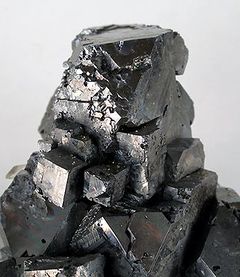
Galena
History of Wanlockhead Lead Mines, Wanlockhead,
Dumfriesshire
Wanlockhead is an old mining village in the parish of Sanquhar.
The discovery of lead around the area is generally attributed to a
Dutch gold prospector, Cornelius de Vois, who was active in this
area of Scotland at the end of the 1560's. However, records show
that mining activity was present as early as 1512 and may first
been exploited by the Romans. In these early days, gold and silver
was being searched for, usually by the means of hushing in the hope
of exposing any veins.
Hushing- Hushing is an ancient and historic mining method
using a flood or torrent of water to reveal mineral veins. The
method was applied in several ways, both in prospecting for ores,
and for their exploitation. Mineral veins are often hidden below
soil and sub-soil, which must be stripped away to discover the ore
veins. A flood of water is very effective in moving soil as well as
working the ore deposits when combined with other methods such as
fire-setting.
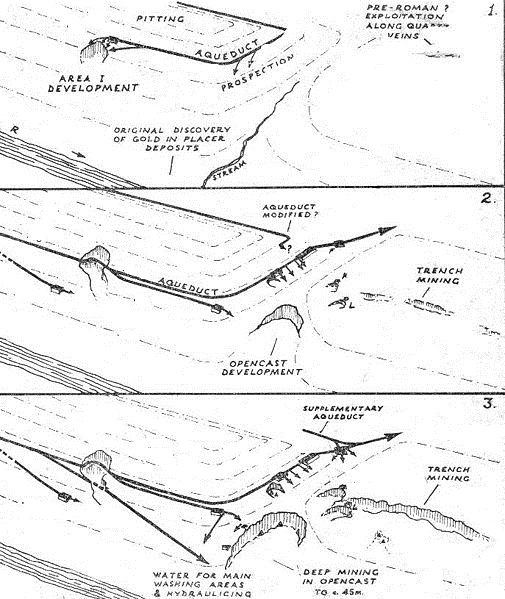
Hushing
In the last two decades of the 17th century, Sir James
Stansfield and a number of others opened mines here. These
operations were on a small scale but Matthew Wilson successfully
worked Margaret's vein (also know as Straitsteps). During this
period smelting lead ore with peat was introduced. After the end of
the lease in 1710, the London Lead Company took over the
Wanlockhead mining grounds. Under their control, the area expanded
into a hive of mining activity - the result of investment and the
introduction of new technology. Many new levels were driven,
"Bab-Gin" pumping engines installed and a new smelter using coal
was built with de-silvering facilities.
In 1723 the London lead Company took out a 'forced' new joint
lease with the Friendly Mining Society, but the partnership was
dissolved after 6 years. The Friendly Mining Society continued to
operate until 1735, but its success was limited and records show
that it operated at a loss. Afterwards, Alexander Telfer took over
the mine leases and operated until 1755. Telfer successfully
expanded up on previous company’s workings and deepened many
of the mines to new horizons. He installed water powered pumping
engines to dewater the deeper workings.
In 1755, a new company, headed by Ronald Crawford took over the
mines and they operated until 1777. After this, their successors
operated with a succession of renewed leases until 1842, when
Marquis of Bute ended up as the last shareholder. During their time
the company proved to be very successful and they mined all the
major veins at Wanlockhead, as well as discovering new veins they
introduced steam powered pumping engines and later on, water
pressure pumping engines. The company proved to be very profitable
for a large part of its tenancy and only in the later years due to
a fall in lead prices did operations see a decline.
When Marquis of Bute's lease expired in 1842, the then
landowner, the Duke of Buccleuch having failed to find new leasees
took over the management of the mines, appointing James Barker
Stuart as manager. Stuart built a new dressing plant and smelt mill
as well as installing new pumping engines and water siphons. In
1870, Thomas Barker Stuart succeeded his father as manager and
continued to improve the mining operations. By the 1890's, the
mining activities were starting to decline and major investment was
required. In the early part of the 20th century, the Duke
terminated mining operations. Two of the hydraulic engines
commission from this era are still preserved underground in the New
Glencrieff workings.
In 1906, two brothers Archiblad and William Fraser took over the
leases and formed the Wanlockhead Lead Mining Company. Employing a
talented mine manager, John Mitchell, the failing operations under
the Duke were turned around, and by 1910 the mines output had
almost doubled. Mitchell introduced compressed air drills and more
powerful pumping engines, allowing deeper workings, which in turn
opened larger ore bodies at a faster rate than was known before. He
also drove much wider levels and used ponies for getting the ore to
the surface. As well as lead, zinc had started to be mined at this
time. After John Mitchell’s death in 1920, his son, William
took over as manager. The mines at this time were facing
difficulties after the 1st World War and the ensuing depression.
However, even with the poor economic climate output of lead was
still very good. Finally in 1934 production ceased and the mines
were closed.
From 1900 Wanlockhead was served by a branch railway from
Elvanfoot via Leadhills, the highest adhesion (i.e. normally
driven) railway in the country, but by then lead mining had already
passed its peak. The railway closed in 1938 following the closure
of most of the area's lead mines. The Leadhills & Wanlockhead
Railway is a 2ft narrow gauge railway built along part of the old
trackbed which currently terminates half a mile from
Wanlockhead.
In 1951 a joint venture between Siamese Tin Syndicate Ltd,
Bangrin Tin Ltd and Rio Tinto Ltd was formed under the name of
Lowland Lead Mines. The group was interested in operations at the
New Glencrieff mine and in 1953 pumping had started to dewater the
flooded workings. A year later when almost a depth of 300m had been
drained, underground exploration and mapping started. Problems were
faced by the group, as there was a shortage of labour and in 1954
Rio Tinto pulled out of the venture. A concentration mill had been
erected at a later date, and over 1600 tonnes of lead concentrated
had been milled. The price of lead fell towards the end of the
1950's and production was stopped in 1958. The mine closed in 1959.
At closure, the reserves were estimated to be at over 200,000
tonnes of lead ore and a further 110,000 tonnes of millable stopes,
with additional tonnage in surface dumps. In the early 1960's a
small venture was started to re-process the old sand lagoons using
a froth floatation plant and this yielded some 3-5% of lead fines.
The only other activities have been the removal of gravels and hard
core for large civil engineering projects.
In the 1980's the local estates granted permission on behalf of
the Wanlockhead Mining Museum for a group of mine explorers headed
by Jeremy Landless to explore the old mine workings. This led to
new understanding of the whole complex and a number of amazing
discoveries, the most prominent being the finding of an intact
water pressure pumping engine and a water pressure winching engine
in the New Glencrieff mine. Today most of the 20th century
industrial surface remains have been demolished, but the earlier
mine buildings are still standing in various states of decline,
with some having under gone restoration or preservation to stop
further decline. There are preserved buildings including the famous
Wanlockhead Beam Engine at Straitsteps Mine, Pate Knows Smelter,
and the Bay Mine area, which is managed by the Wanlockhead Mining
Museum.
Access to the underground workings is still possible, but the
local estates frown up on it, with most of the mines being locked,
hidden and buried - a shame, as contemporary mine explorers surely
would be able to unearth a vast amount of industrial heritage that
is currently hidden away. The area is now the Scottish location of
the annual Gold Panning World Championships.
With thanks to: Mine Explorer
The Lead
Mining Museum
Undiscovered Scotland
Scottish Geology Wikipedia
The Duke of Edinburgh Award Organisation
Mining Basics
To log this cache:
- Along the valley of Wanlock Water, there is a mine tip near the
New Glencrieff Mine that has a sharp ridge – estimate its
height.
- Scour the waste for a short time – try to identify some
Galena and describe it using information from this page. Do you see
any other minerals?
- Take a photo of one piece of evidence for the mining in this
valley with you and/or your GPS and publish it with your log.
- Try to work out what the beam engine contributed to mining in
this area.
- Email me with the answers to log this cache

Official EarthCache Banner
Please note the following from Scottish Natural Heritage
Access to the SSSI should follow the Scottish Outdoor Access
Code (SOAC). Sampling from exposures should only take place in
accordance with the Geological Code and wherever possible
photographs rather than samples should be taken. Access to a mining
shaft is available by guided tour from the Lead Mining Museum in
Wanlockhead.
The main threat to the condition of the spoil dumps is from
mineral collectors removing large numbers of samples. As the supply
of such material is limited, the irresponsible collecting of
samples would reduce the interest of the site. Mineral collecting
should only be carried out by experienced researchers and subject
to the recognised collecting code of practice (ie appropriate
recording of data and making important finds available to suitable
establishments such as museums). Any finds should be reported to
SNH and the local museum service and appropriately catalogued and
photographed.